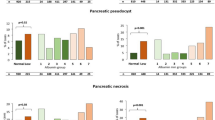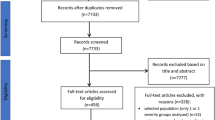Abstract
The incidence of acute pancreatitis varies considerably between regions and is estimated at 5–80 per 100,000 population. The mortality rate of acute edematous-interstitial pancreatitis is below 1%, whereas 10–24% of patients with severe acute pancreatitis die. The early prognostic factors that can be used to determine whether the clinical course is likely to be severe are three or more signs of organ failure according to the Ranson or Imrie scores, the presence of nonpancreatic complications, and the detection of pancreatic necrosis by imaging techniques. Elevated C-reactive protein levels above 130 mg/l can also predict a severe course of acute pancreatitis with high sensitivity. Although no causal treatment exists, replacing the dramatic fluid loss that takes place in the early disease phase is critical and determines the patient's prognosis. Adequate pain relief with opiates is another therapeutic priority. In patients with pancreatic necrosis, the high mortality rate between the third and fourth week after the initial episode is determined largely by the development of pancreatic infection, and can therefore be reduced by early antibiotic treatment. Early enteral nutrition for the treatment of acute pancreatitis has been shown to be superior and much more cost-effective than parenteral nutrition. Infected pancreatic necrosis or pancreatic abscess are two of the few remaining indications for open surgery in acute pancreatitis. Even when indicated, surgery is frequently delayed or even replaced by minimally invasive surgical techniques.
This is a preview of subscription content, access via your institution
Access options
Subscribe to this journal
Receive 12 print issues and online access
$209.00 per year
only $17.42 per issue
Buy this article
- Purchase on Springer Link
- Instant access to full article PDF
Prices may be subject to local taxes which are calculated during checkout



Similar content being viewed by others
References
Banks PA (2002) Epidemiology, natural history, and predictors of disease outcome in acute and chronic pancreatitis. Gastrointest Endoscopy 56: 226–230
Bank S et al. (2002) Evaluation of factors that have reduced mortality from acute pancreatitis over the past 20 years. J Clin Gastroenterol 35: 50–60
Balthazar EJ et al. (1990) Acute pancreatitis: value of CT in establishing prognosis. Radiology 174: 331–336
Johnson CD et al. (2004) Persistent organ failure during the first week as a marker of fatal outcome in acute pancreatitis. Gut 53: 1340–1344
Balthazar EJ et al. (1994) Imaging and intervention in acute pancreatitis. Radiology 193: 297–306
Mortele KJ et al. (2004) A modified CT severity index for evaluating acute pancreatitis: improved correlation with patient outcome. Am J Roentgenol 183: 1261–1265
Uhl W et al. (2002) Influence of contrast-enhanced computed tomography on the course and outcome in patients with acute pancreatitis. Pancreas 24: 191–197
Arvanitakis et al. (2004) Computed tomography and magnetic resonance imaging in the assessment of acute pancreatitis. Gastroenterology 126: 715–723
Balthazar EJ (2002) Acute pancreatitis: assessment of severity with clinical and CT evaluation. Radiology 223: 603–613
Buchler M et al. (1986) Value of biochemical and imaging procedures for the diagnosis of acute pancreatitis—results of a prospective clinical study. Z Gastroenterol 24: 100–109
Neoptolemos JP et al. (2000) Early prediction of severity in acute pancreatitis by urinary trypsinogen activation peptide: a multicentre study. Lancet 355: 1955–1960
Lempinen M et al. (2001) Predicting the severity of acute pancreatitis by rapid measurement of trypsinogen-2 in urine. Clin Chem 47: 2103–2107
Brown A et al. (2000) Hemoconcentration is an early marker for organ failure and necrotizing pancreatitis. Pancreas 20: 367–372
Lankisch PG et al. (2001) Hemoconcentration: an early marker of severe and/or necrotizing pancreatitis? A critical appraisal. Am J Gastroenterol 96: 2081–2085
Shafiq N et al. (2005) Estimating the diagnostic accuracy of procalcitonin as a marker of the severity of acute pancreatitis: a meta-analytic approach. JOP 6: 231–237
Rau BM et al. (2005) Assessment of major complications and overall prognosis by the SOFA, APACHE II and MOF Score in severe acute pancreatitis [abstract #98]. Pancreatology 5
Klar E et al. (1993) Improvement of impaired pancreatic microcirculation by isovolemic hemodilution protects pancreatic morphology in acute biliary pancreatitis. Surg Gynecol Obstet 176: 144–150
Brown A et al. (2002) Can fluid resuscitation prevent pancreatic necrosis in severe acute pancreatitis? Pancreatology 2: 104–107
Powell JJ et al. (2000) Randomized controlled trial of the effect of early enteral nutrition on markers of the inflammatory response in predicted severe acute pancreatitis. Br J Surg 87: 1375–1381
Pupelis G et al. (2001) Jejunal feeding, even when instituted late, improves outcomes in patients with severe pancreatitis and peritonitis. Nutrition 17: 91–94
Windsor AC et al. (1998) Compared with parenteral nutrition, enteral feeding attenuates acute phase response and improves disease severity in acute pancreatitis. Gut 42: 431–435
Karamitsios N et al. (1997) Enteral nutrition in acute pancreatitis. Nutr Rev 55: 279–282
McClave SA et al. (1997) Comparison of the safety of early enteral vs parenteral nutrition in mild acute pancreatitis. J Parenter Enteral Nutr 21: 14–20
Olah A et al. (2002) Early nasojejunal feeding in acute pancreatitis is associated with a lower complication rate. Nutrition 18: 259–262
Gupta R et al. (2003) A randomised clinical trial to assess the effect of total enteral and total parenteral nutritional support on metabolic, inflammatory and oxidative markers in patients with predicted severe acute pancreatitis (APACHE II > or =6). Pancreatology 3: 406–413
Marik PE (2004) Meta-analysis of parenteral nutrition versus enteral nutrition in patients with acute pancreatitis. BMJ 328: 1407
Ockenga J et al. (2002) Effect of glutamine-enriched total parenteral nutrition in patients with acute pancreatitis. Clin Nutr 21: 409–416
Sarr MG et al. (1986) Prospective, randomized trial of nasogastric suction in patients with acute pancreatitis. Surgery 100: 500–504
Eatock FC et al. (2005) A randomized study of early nasogastric versus nasojejunal feeding in severe acute pancreatitis. Am J Gastroenterol 100: 432–439
Boivin M (1990) Are diets associated with different rates of human interdigestive and postprandial pancreatic enzyme secretion? Gastroenterology 99: 1763–1771
Kahl S et al. (2004) Procaine hydrochloride fails to relieve pain in patients with acute pancreatitis. Digestion 69: 5–9
Lerch MM (2004) No more intravenous procaine for pancreatitis pain? Digestion 69: 2–4
Thompson DR (2001) Narcotic analgesic effects on the sphincter of Oddi: a review of the data and therapeutic implications in treating pancreatitis. Am J Gastroenterol 96: 1266–1272
Bernhardt A et al. (2002) Using epidural anesthesia in patients with acute pancreatitis–prospective study of 121 patients. Anaesthesiol Reanim 27: 16–22
Jorgensen H et al. (2000) Epidural local anaesthetics versus opioid-based analgesic regimens on postoperative gastrointestinal paralysis, PONV and pain after abdominal surgery. The Cochrane Database of Systematic Reviews, Issue 4, Art. No CD001893
Luiten EJ et al. (1998) Prognostic importance of gram-negative intestinal colonization preceding pancreatic infection in severe acute pancreatitis. Results of a controlled clinical trial of selective decontamination. Intensive Care Med 24: 438–445
Besselink MGH et al. (2004) Probiotic prophylaxis in patients with predicted severe acute pancreatitis (PROPATRIA): design and rationale of a double-blind, placebo-controlled randomised multicenter trial. BMC Surgery 4: 12
Gerzof SG et al. (1981) Percutaneous catheter drainage of abdominal abscesses: a five-year experience. N Engl J Med 305: 653–657
Beger HG et al. (1986) Bacterial contamination of pancreatic necrosis. A prospective clinical study. Gastroenterology 91: 433–438
Golub R et al. (1998) Role of antibiotics in acute pancreatitis: A meta-analysis. J Gastrointest Surg 2: 496–503
Isenmann R et al. (2004) Prophylactic treatment in patients with predicted severe acute pancreatitis: a placebo controlled, double blind trial. Gastroenterology 126: 997–1004
Bassi C et al. (2003) Antibiotic therapy for prophylaxis against infection of pancreatic necrosis in acute pancreatitis. The Cochrane Database of Systematic Reviews, Issue 4, Art No. CD002941
Farkas G et al. (1998) Progress in the management and treatment of infected pancreatic necrosis. Scand J Gastroenterol 228: 31–37
De Waele JJ et al. (2003) Fungal infections in patients with severe acute pancreatitis and the use of prophylactic therapy. Clin Infect Dis 37: 208–213
Shrikande S et al. (2000) Fulconazole penetration into the pancreas. Antimicrob Agents Chemother 44: 2569–2571
Neoptolemos JP et al. (1998) Controlled trial of urgent endoscopic retrograde cholangiopancreatography and endoscopic sphincterotomy versus conservative treatment for acute pancreatitis due to gallstones. Lancet 2: 979–983
Folsch UR et al. (1997) Early ERCP and papillotomy compared with conservative treatment for acute biliary pancreatitis. The German study group on Acute Biliary Pancreatitis. N Engl J Med 336: 237–242
Fan ST (1993) Early treatment of acute biliary pancreatitis by endoscopic papillotomy. N Engl J Med 328: 228–232
Sharma VK et al. (1999) Metaanalysis of randomized controlled trials of endoscopic retrograde cholangiography and endoscopic sphincterotomy for the treatment of acute biliary pancreatitis. Am J Gastroenterol 94: 3211–3214
Thorboll J et al. (2004) Endoscopic ultrasonography in detection of cholelithiasis in patients with biliary pain and negative transabdominal ultrasonography. Scand J Gastroenterol 39: 267–269
Saraswat VA et al. (2004) Biliary microlithiasis in patients with idiopathic acute pancreatitis and unexplained biliary pain: response to therapy. J Gastroenterol Hepatol 19: 1206–1211
UK working party on acute pancreatitis (2005) UK guidelines for the management of acute pancreatitis. Gut 54: 1–9
Uhl W et al. (1999) Acute gallstone pancreatitis: timing of laparoscopic cholecystectomy in mild and severe disease. Surg Endosc 13: 1070–1076
Hartwig W et al. (2002) Reduction in mortality with delayed surgical therapy of severe pancreatitis. J Gastrointest Surg 6: 481–487
Mier J et al. (1997) Early versus late necrosectomy in severe necrotising pancreatitis. Am J Surg 173: 71–75
Werner J et al. (2005) Management of acute pancreatitis: from surgery to interventional intensive care. Gut 54: 426–436
Shankar S et al. (2004) Imaging and percutaneous management of acute complicated pancreatitis. Cardiocasc Intervent Radiol 27: 567–580
Acknowledgements
The authors thank N Hosten and the Department of Diagnostic Radiology, Ernst-Moritz-Arndt University, Greifswald, Germany, for their assistance in preparing Figure 1.
Author information
Authors and Affiliations
Corresponding author
Ethics declarations
Competing interests
The authors declare no competing financial interests.
Rights and permissions
About this article
Cite this article
Mayerle, J., Hlouschek, V. & Lerch, M. Current management of acute pancreatitis. Nat Rev Gastroenterol Hepatol 2, 473–483 (2005). https://doi.org/10.1038/ncpgasthep0293
Received:
Accepted:
Issue Date:
DOI: https://doi.org/10.1038/ncpgasthep0293
This article is cited by
-
Potential Effects of Calcium Binding Protein S100A12 on Severity Evaluation and Curative Effect of Severe Acute Pancreatitis
Inflammation (2015)
-
Role of Liver in Modulating the Release of Inflammatory Cytokines Involved in Lung and Multiple Organ Dysfunction in Severe Acute Pancreatitis
Cell Biochemistry and Biophysics (2015)
-
d‐dimer as a marker of severity in patients with severe acute pancreatitis
Journal of Hepato-Biliary-Pancreatic Sciences (2012)
-
Summary of integrative medicine for severe acute pancreatitis: 26-year clinical experiences and a report of 1 561 cases
Chinese Journal of Integrative Medicine (2011)
-
Akute Pankreatitis
Der Gastroenterologe (2006)



